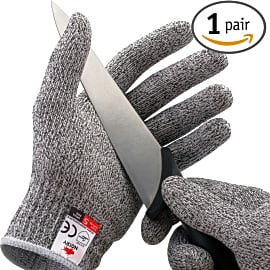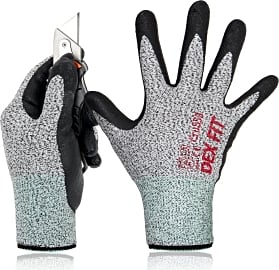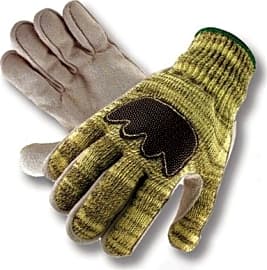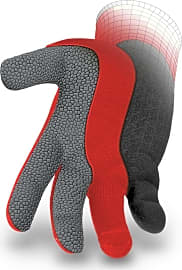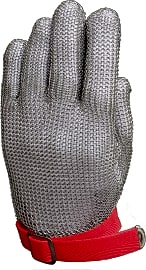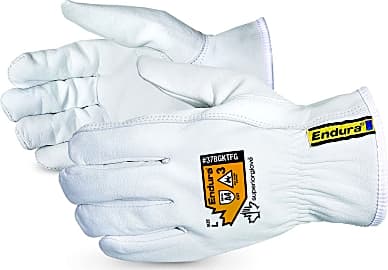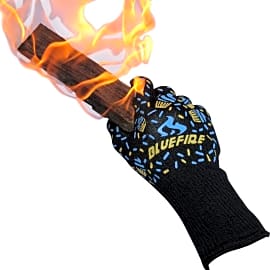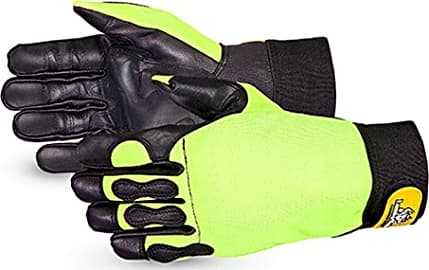The 10 Best Cut Proof Gloves

This wiki has been updated 37 times since it was first published in October of 2015. While there is no such thing as 100 percent cut-proof, cut-resistant gloves are a smart choice for many tasks, including landscaping, woodworking, and cooking. They can save you from a trip to the hospital in the event of a slipped blade or equipment malfunction. Here are some of the most advanced options, made from a range of materials offering varying levels of protection. When users buy our independently chosen editorial picks, we may earn commissions to help fund the Wiki.
Editor's Notes
December 04, 2020:
First of all, we need to note one important thing. When looking for a good pair of cut gloves, you'll probably see marketing images that demonstrate just how effective the gloves are by directly gripping the blade of a knife with one hand. We cannot stress enough that this is not a safe way to rate, test, or use these gloves. Few cut gloves, especially those meant for culinary use, will keep your hands safe if intentionally pushed to their limits.
With that out of the way, the Mercer Millenia is one of the best choices for most cooks. It's thin but still highly protective, and if you want something even safer, there's an A7 model that will do an even better job of thwarting a razor-sharp chef's knife. Alternatively, the NoCry 1M has a little bit more elasticity, but it doesn't come in as many sizes. Keep in mind that both of these are sold as a single unit, and you generally only wear one on your non-dominant hand, as they can make it hard to use a knife. The BlueFire Pro are also interesting for cooking, and although they aren't ideal for use in a professional kitchen, they're simply great for a barbecue at home. The Anself Stainless Steel rounds out the kitchen-focused models, and one of these is actually legally required in many states when using an electric slicer.
Outside of culinary use, there's a huge variety of interesting choices. The Endura 385CS are designed to dampen vibrations and even withstand a hit from a chainsaw. The HexArmor Blademaster Ultimate and HexArmor 9011 are both made from premium specialty materials meant to withstand long-term use and hold up to dangerous tools. Meanwhile, the Superior Glove Dexterity offer some of the most resilient armor on the market.
Those are the heavy-duty options, but there are certainly some in the middle. Notably, the Endura 378 don't have and rigid armor, so they don't hurt your dexterity too much, but still offer plenty of protection. The Dex Fit Cru533 are even more pliable, although they don't offer nearly as much protection to the back of the hand as they do the palm, where they're lined with Kevlar.
July 05, 2019:
Make no mistake, few gloves are completely impervious to cuts. You can certainly still stab yourself while wearing a cut-resistant glove -- I would know, I've done it -- but if you do, the results will be far less disastrous than if you weren't wearing personal protective equipment. With that said, you'll find a wide range of gloves designed for various purposes.
If you're working with food, you want either the NoCry or Anself. The NoCry is immensely popular and one of the most tried-and-true of the countless inexpensive options for culinary use. It's lightweight and breathable and doesn't get in the way of advanced knife technique. The Anself is, of course, quite bulky (it's made of steel, after all), but it will hold up even to high-speed meat slicers, and especially in many corporate culinary jobs, it's an absolute requirement. The BlueFire are interesting because they also serve as high-dexterity oven mitts, and they're great for keeping your wrists and forearms free from painful burns. None of these culinary gloves should be used for industrial or power tool work, however; they're meant to prevent cuts from kitchen knives, not saws or metal stamping machines.
If you do need something for protection from machinery, the Endura 378s are the simplest, and thanks to their high-quality materials, are also quite comfortable. They're not intended for high-precision work, though. Endura also makes a set of gloves that are remarkably effective for keeping safe while using the notoriously dangerous chainsaw. The SalviMar Dy-Max help you retain more flexibility, as they're made from advanced Dyneema fibers, which are considerably stronger than steel even though they're much lighter. The Dexterity by Superior Glove offer more all-around protection than almost anything else, as they'll keep you from banging up your knuckles in many situations. And the HexArmor options use the brand's patented SuperFabric, which boasts puncture protection superior to almost anything else on the market.
Special Honors
Majestic Gloves Industry professionals such as linemen, mechanics, and even firefighters should consider some of these high-end models for everyday use. They're made using the finest materials, including premium Kevlar formulas and other fire- and heat-resistant fabrics, many have near-indestructible armor, and their construction quality is about as good as it gets. majesticglove.com
Clear From The Cuts
My secret was a good cut-proof glove, what we called cut gloves in the business.
Nobody wants to lose a finger. I worked a job for about five years that required constant interaction with knives and food, and in five years on the job I only cut myself twice.
How did I go so long without losing a digit? Well, I didn't have a good knife technique, if that's what you're thinking. I didn't learn the claw grip until long after I left that job. I didn't have very good knives either. It's much harder to accidentally cut yourself with a good, sharp knife, but I was using low-quality knives.
My secret was a good cut-proof glove, what we called cut gloves in the business. I was fortunate enough to meet the cut glove just days after my second finger slice on the job. I was doing an impression of those fancy chefs at Japanese steakhouses who throw their knives through the air and catch them. Please note, unless your chef's knife is well-balanced enough to fly through the air with any degree of predictability, you're more or less guaranteed to cut yourself trying to catch it.
The glove my coworker handed me didn't look like it could stop a knife, so I took a a long carrot and fitted it to one of the finger holes, then proceeded to try my best to cut through it and into the carrot. I could not. My coworker explained that the gloves we made of a material akin to bite-proof wet suits, or the armor divers wear when they go swimming among sharks.
It turns out shark teeth operate on a principal quite similar to that of a good chef's knife. Along the edge of a good knife are tiny, microscopic peaks and valleys, almost what you might consider serrations. These peaks and valleys catch on the surfaces of whatever you drag them across, breaking the surface of a given food with a combination of friction, tension, and pressure. The more friction and tension you have, the less pressure you need, which is why dull knives are so dangerous; they require you to add unsafe amounts of pressure to your cut.
Cut gloves combine a few possible materials to resist the cutting potential of a given knife. More recently, polyethylene fibers have been among the most popular materials, though you'll see cut gloves combining cotton, spandex, glass fiber, Kevlar, and stainless steel to keep the cuts at bay. Some companies will interweave several different materials to maximize the benefits of each while reducing costs, while others prefer to use a single material.
Material Witnesses
In addition to being tremendously resistant to the swipe of a blade, the great thing about most polyethylene fabrics is that they're very inexpensive. Once you reach outside the polyethylene models, however, you'll see a modest uptick in the prices available, but these reflect potential increases in versatility and durability, as well.
Take the glove that touts fire-resistant qualities right up there with its cut resistance, for example. This glove uses a lot of Kevlar fibers in its construction, and Kevlar is famously flame-resistant. It's a little impractical for firefighters to deck themselves out head-to-toe with the stuff, since it's heavy and doesn't breathe very well, but it makes for a very versatile glove.
As a chef, musician, and writer, the idea of someone actually trying to prove a glove's cut resistance in the real world terrifies me.
With a Kevlar cut glove, you can go from slicing up something tasty on your cutting board to taking a hot pan out of the oven without even thinking about it. The downside to Kevlar is that it doesn't grip very well, which is why you see that added bit of rubberized traction material on the glove.
Other materials, like the stainless steel that makes up the entirety of our number one glove, tend to be a little pricier. In the case of the stainless steel glove, specifically, you can expect a little more durability than you would out of a polyethylene glove. Steel fibers will hold up much better to unexpected heat or years of non-use in a way that the synthetic stuff will not.
Additionally, different materials will move and fit very differently. Depending on what you're cutting and how precisely you need to cut it, you can get away with differing degrees of flexibility and comfort. Steel and Kevlar materials tend to be a little less flexible, and are better for less nuanced work, where polyethylene and cotton-based gloves will give you the most articulation.
There are a couple more important practical points to be made. When you receive your new cut-resistant glove, do not test it out by trying to slice it open. You might think this goes without saying, but an alarming number of user reviews say something like, "I had to see if it worked, so I grabbed my knife and proceeded to try and slice through my palm." As a chef, musician, and writer, the idea of someone actually trying to prove a glove's cut resistance in the real world terrifies me. The fact is, there's no such thing as an entirely cut-proof glove; they're only resistant, not impervious to damage. I've absolutely lost chunks of flesh to an oyster knife, even while wearing a "cut-proof" glove, and a properly honed mandoline will, over time, start to rip through the fingertips of even the most reliable kitchen glove.
Also, you'll see in many pictures people using these gloves to grip food directly. Don't do that. If you're going to wear a cut glove, it's recommended (and if you're at work, legally required) that you use a food-safe glove on top. Bacteria and foreign objects can get lodged in cut gloves and transfer to food if you're not wearing a nitrile or latex glove on the outside. Even chain gloves, which can be sanitized, work better with an elastic glove around them.
Revolutions In Protection
Long before chefs or factory workers had to concern themselves with the dangers of their professions, it was the fighters of the warrior class who sought to reduce the impact of swords and knives on their bodies. The history of battle armor is long and storied, and evidence of scale armor–a predecessor to chain mail–exists in a book of ancient Chinese poetry that's at least 3,000 years old.
The first cut gloves were produced with a capitalist's bottom line in mind, not just the safety of his workers.
Chain mail itself, which is remarkably similar in construction to the stainless steel cut gloves on our list, came about around the 4th or 5th century BCE, depending on whether you credit the Persians of modern day Iran, the Celts of modern day Ireland, or the Dacians of Romania with its invention.
The first cut gloves were produced with a capitalist's bottom line in mind, not just the safety of his workers. Throughout the Industrial Revolution, manufacturers looked for ways to keep turnover down in their labor forces, which forced them to find innovative ways to reduce downtime caused by injury.
As materials research developed on through the 20th century, particularly ballistics research intended to protect our military servicemen and police officers, more cut-resistant materials made their way onto the market.



